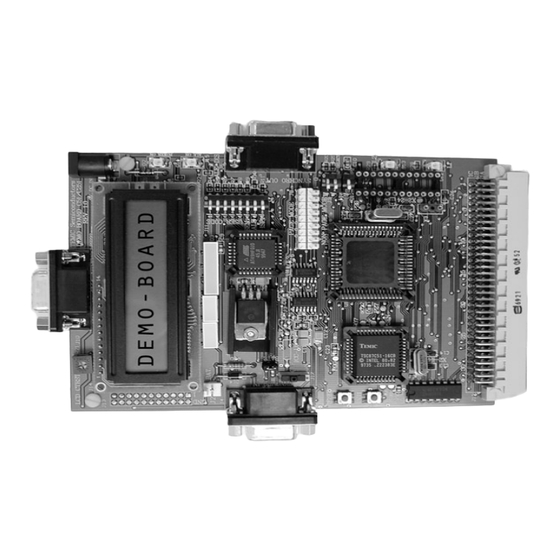
Table of Contents
Advertisement
Quick Links
External Brown-out Protection for C51
Microcontrollers with Active High Reset Input
Features
•
Low-voltage Detector
•
Prevents Register and EEPROM/Flash Corruption
•
One Discrete Solution
•
Integrated IC Solution
•
Low-power/Low-cost Solution
•
Formulas for Component Value Calculations
•
Complete with Sample Schematics
Introduction
This application note shows in detail how to prevent system malfunction during peri-
ods of insufficient power supply voltage. It describes techniques to prevent the MCU
from executing code during periods of insufficient voltage by using external low volt-
age detectors. These events are often referred to as "Brown-outs", where power
supply voltage drops to an insufficient level, or "Black-outs" where power supply volt-
age totally disappear for a period of time.
One discrete solution is discussed in detail, allowing the user to calibrate the system
requirements. A complete guide to Integrated Circuit (IC) solutions is also included. By
implementing these techniques, the following can be prevented:
•
MCU Register Corruption
•
I/O Register Corruption
•
I/O-pin Random Toggling
•
On-chip Memory Corruption (SRAM, EEPROM, Flash)
•
External Memory Corruption
C51
Microcontrollers
Application
Note
Rev. 4183A–80C51–11/02
1
Advertisement
Table of Contents

Summary of Contents for Atmel C51
- Page 1 External Brown-out Protection for C51 Microcontrollers with Active High Reset Input Features Microcontrollers • Low-voltage Detector • Prevents Register and EEPROM/Flash Corruption • One Discrete Solution Application • Integrated IC Solution • Low-power/Low-cost Solution Note • Formulas for Component Value Calculations •...
-
Page 2: Theory Of Operation
The memory will keep its present content for the duration of the Reset. chip Memory Corruption Without a Detector, random MCU activity such as described in the introduction may write an unknown value to any volatile on-chip memory location. C51 MCUs 4183A–80C51–11/02... -
Page 3: Design Criteria
Without a Detector, random MCU activity could initialize an unintended write to the non- volatile memory. This may cause random corruption of the memory contents. Since the C51 MCU is capable of writing to its own program memory, the internal Flash Program memory contents could be affected by a power failure situation. -
Page 4: Operating Voltage Range
1 volt. Under these conditions, the Brown-out circuit must generate a valid RST signal. Output Transition Delay Output transition (propagation delay and slew rate) must be fast enough to stop the MCU before it causes memory corruption or unexpected behavior of peripherals. C51 MCUs 4183A–80C51–11/02... - Page 5 C51 MCUs Implementation A variety of Integrated Circuit (IC) solutions are available from different manufacturers. These solutions offer high accuracy at a low price, typically they guarantee the threshold voltage to be within ± 1%. Although the elementary three-pin fixed voltage detector is...
- Page 6 High Component Count • Long Response Time against V (1) (2) Figure 2. Low-power Consumption Brown-out Detector OPTIONAL RESET SWITCH Optional OPTIONAL Reset Switch RESET SWITCH Crst C51 MCU 1µF C51 MCU Crst C51 MCU 1µF Rrst HWDT Rrst HWDT 1-5K 50-200K...
-
Page 7: Selecting Components
C51 MCUs Introduction The circuit shown in Figure 2 on page 6 benefits from low-power consumption, which makes it suitable for battery operated applications. Standard discrete components pro- vide a low cost design. The voltage transition on the RST pin is very steep. Combined with the large hysteresis, the accuracy is high. -
Page 8: Response Time
Capacitors C1, C2 and C3 are decoupling capacitors to minimize noise sensitivity to both RF and 50/60 Hz fields. They can all be omitted, but the noise immunity greatly depends on the values selected. C51 MCUs 4183A–80C51–11/02... -
Page 9: Power Consumption
C51 MCUs Threshold Accuracy Because the threshold voltage is defined mainly by R1 and R2, inaccuracies in these resistors directly influence the threshold voltage accuracy. It is recommended to choose these with ± 1% tolerance. Power Consumption The current consumption in normal operating mode (sufficiently high V ) is found by: ... - Page 10 ≥ 100 BC548/BC848/2N3904 ≤ 1% 6.04 MΩ 6.19 MΩ ≤ 1% 1.3 MΩ 820 kΩ ≤ 20% 1.5 MΩ ≤ 20% 510 KΩ ≤ 20% 100 kΩ ≤ 20%, Z5U dielectric or better C1, C2, C3 100 nF C51 MCUs 4183A–80C51–11/02...
- Page 11 A selection of integrated circuits is available from various semiconductor suppliers. They vary from simple 3-pin fixed voltage detectors to advanced circuitry containing Watch- dog Timers and Power-on Reset (POR) Time-outs. Because some C51 MCUs have built-in Watchdog and POR circuitry, these functions do not need to be handled by the external IC.
-
Page 12: Power Regulator
Solutions source currently supplies power to the circuit. Connecting this signal to an input pin, the C51 MCU can detect the event and execute a safe power-down sequence, switching off power hungry peripheral equipment (motor, display etc.) before entering Power-down mode. -
Page 13: Operating Voltage
C51 MCUs Hysteresis Hysteresis in the Low-voltage Detector might be implemented in the integrated circuit, or can be added with external circuitry (Figure 7). This prevents the detector from oscillat- ing when used in battery applications. Figure 7. Adding Hysteresis to Threshold Voltage... - Page 14 : 3.235V = 3V OUTMIN < 3.235V : 3.365V = 3.15V OUTMAX T89C51CC01 : 3V CCMIN MC7805 : ADM810M : 5.5V T89C51CC02 > 3V CCMAX : 4.75V = 4.25V OUTMIN < 4.75V : 5.25V = 4.5V OUTMAX C51 MCUs 4183A–80C51–11/02...
- Page 15 No licenses to patents or other intellectual property of Atmel are granted by the Company in connection with the sale of Atmel products, expressly or by implication. Atmel’s products are not authorized for use as critical components in life support devices or systems.














Need help?
Do you have a question about the C51 and is the answer not in the manual?
Questions and answers